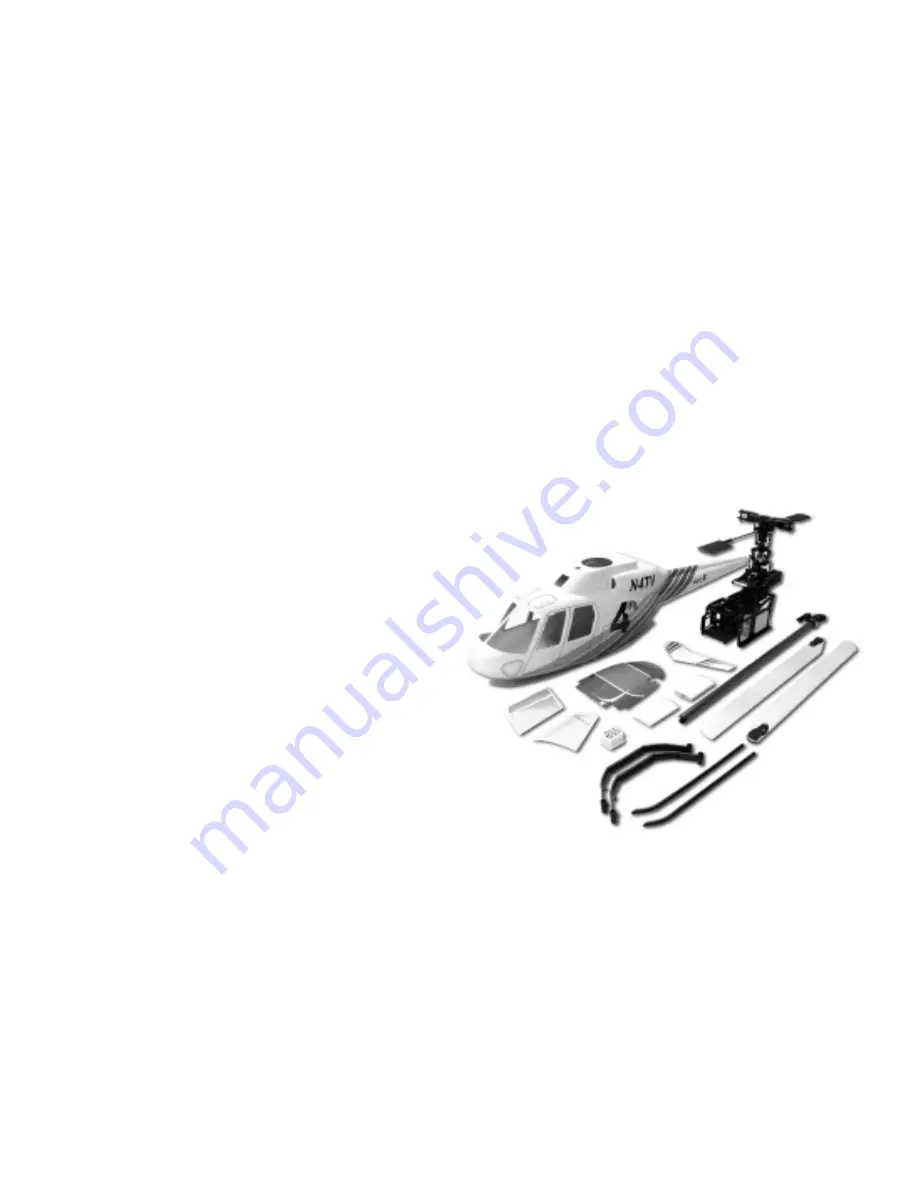
4
The mechanics (completely built helicopter without body) should be flight ready. At this point the helicopter
should essentially be together without the fuselage, this can be accomplished with the scale mechanics instruction
manual that comes with the kit and ARF versions. For the kit version, complete all the fitting before painting.
The final items that need to be finished are:
1. The battery pack and the receiver (wrapped in foam) are installed in front or below the battery tray. If mounting
infront for balance, suitable anchoring need to be fabricated to securely hold the items.
2. The antenna needs to be routed to the tail gearbox with out contacting any metal or wiring. Optional short whip
antennas are great but either method needs to be routed correctly.
3. Remote glow plug adapter and fueling system needs to be installed (purchased separately).
4. The engine Run-in will require 2-4 tanks of fuel to get the engine running smoothly (with main blades).
5. Rudder pushrod length needs to be shortened and adjusted based on the rudder setup instructions.
6. During the Run-in, cycle the throttle to lift-off and trim the rudder while setting up the gyro.
Do not fly the helicopter at this stage, the mechanics are designed for the scale fuselage and is not balanced for
extended hovering or forward flight. Also note that the is no tail support strut or tail fins (apart of the fuselage)
for stability.
Section Two: Fuselage Preparation
Section Two: Fuselage Preparation
Section Two: Fuselage Preparation
Section Two: Fuselage Preparation
Section Two: Fuselage Preparation
STEP 1 Muffler Cutout & Clearance
STEP 1 Muffler Cutout & Clearance
STEP 1 Muffler Cutout & Clearance
STEP 1 Muffler Cutout & Clearance
STEP 1 Muffler Cutout & Clearance
If you are installing the optional CN3058 Scale 30 size
muffler the cutout in the fuselage is already completed.
The fuselage is designed to use the scale muffler from
Century, either the CN3058 (30 size) or the CN3059
(46-50 size) that can be purchase separately. These
mufflers are box like and fit very close to the scale
mechanics making them an ideal choice. Standard
torpedo style mufflers simply will not work because they
require cutting out the side of the fuselage. It is common and
recommended to use an optional exhaust diverter that extends
the muffler exhaust out past the edge of the fiberglass, however it
maybe necessary to enlarge the hole in the fuselage depending on the
type used, Century offers CN3014, CN3015 & CN3016 that can be
trimmed to fit.
Section One: Completing the helicopter mechanics.
Section One: Completing the helicopter mechanics.
Section One: Completing the helicopter mechanics.
Section One: Completing the helicopter mechanics.
Section One: Completing the helicopter mechanics.
ARF
ARF
ARF
ARF
ARF V
V
V
V
Ver
er
er
er
ersion
sion
sion
sion
sion
For the CN3059 Scale 46-50 size muffler, the cutout will need to be slotted as the position of the exhaust outlet is
slightly offset. If another exhaust system is going to be installed, make the cutout for the exhaust at this time.
Kit
Kit
Kit
Kit
Kit V
V
V
V
Ver
er
er
er
ersion
sion
sion
sion
sion
No further work is necessary if mounting the optional CN3058 Scale muffler. For all other mufflers, trace the
template in the back of the scale mechanics manual, install the preferred muffler and mark the hole for the exhaust.
Using a sharp pencil, pierce the holes for the side frame and the appropriate exhaust center mark that corresponds
to your muffler. While holding the rear fuselage upside down, align the pierced “side frame” holes. Using a
marker, mark the center and draw the circle for the exhaust hole. Using a moto-tool and a grinding stone, make
the hole in the bottom of the fuselage and the bottom hatch. Alternately, the hole can be drilled inside the final
diameter and filed or hand sanded to the final size.
Twinstar Detail Manual
Twinstar Detail Manual
Twinstar Detail Manual
Twinstar Detail Manual
Twinstar Detail Manual
































